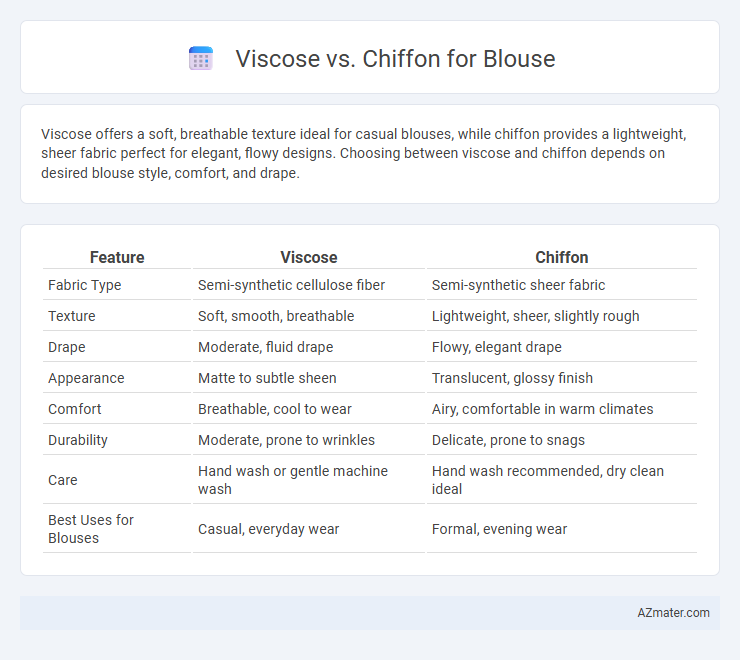Viscose offers a soft, breathable texture ideal for casual blouses, while chiffon provides a lightweight, sheer fabric perfect for elegant, flowy designs. Choosing between viscose and chiffon depends on desired blouse style, comfort, and drape.
Table of Comparison
| Feature | Viscose | Chiffon |
|---|---|---|
| Fabric Type | Semi-synthetic cellulose fiber | Semi-synthetic sheer fabric |
| Texture | Soft, smooth, breathable | Lightweight, sheer, slightly rough |
| Drape | Moderate, fluid drape | Flowy, elegant drape |
| Appearance | Matte to subtle sheen | Translucent, glossy finish |
| Comfort | Breathable, cool to wear | Airy, comfortable in warm climates |
| Durability | Moderate, prone to wrinkles | Delicate, prone to snags |
| Care | Hand wash or gentle machine wash | Hand wash recommended, dry clean ideal |
| Best Uses for Blouses | Casual, everyday wear | Formal, evening wear |
Introduction to Viscose and Chiffon Fabrics
Viscose is a semi-synthetic fiber derived from cellulose, known for its softness, breathability, and fluid drape, making it ideal for comfortable blouses. Chiffon is a lightweight, sheer fabric typically made from silk, nylon, or polyester, characterized by its delicate, slightly rough texture and elegant, airy appearance. Both fabrics offer unique qualities suited for different blouse styles, with viscose favoring casual comfort and chiffon excelling in formal, flowy designs.
Key Characteristics of Viscose
Viscose fabric is known for its silky texture, lightweight feel, and excellent breathability, making it ideal for blouses in warm weather. It drapes beautifully and offers good moisture absorption, providing comfort throughout the day. Unlike chiffon, viscose has a softer hand and more substantial weight, allowing for versatile styling options in blouse designs.
Key Characteristics of Chiffon
Chiffon is a lightweight, sheer fabric characterized by its delicate, airy texture and slightly rough feel, often made from silk, polyester, or nylon. It drapes beautifully, creating a soft, flowing silhouette ideal for blouses that require elegance and breathability. The semi-transparent quality of chiffon adds a subtle allure and is typically used in layered or lined designs to balance modesty with style.
Comfort and Breathability Comparison
Viscose offers superior breathability and softness, making it an excellent choice for comfortable blouses in warm weather. Chiffon, while lightweight and airy, tends to be less breathable due to its sheer, synthetic blend, which can retain heat and moisture. For those prioritizing comfort and airflow, viscose provides a smoother feel against the skin and better moisture absorption than chiffon.
Durability and Longevity Factors
Viscose offers moderate durability due to its semi-synthetic cellulose fibers, making it prone to weakening when exposed to excessive moisture or heat during washing, which can affect the blouse's longevity. Chiffon, typically made from silk, polyester, or nylon, is lightweight and delicate but polyester chiffon provides enhanced durability and resistance to wear compared to silk chiffon, extending the blouse's lifespan. Proper care, such as gentle hand washing and avoiding high heat, is essential for both fabrics to maintain their appearance and durability over time.
Aesthetic Appeal: Texture and Sheen
Viscose offers a smooth texture with a soft, natural sheen that enhances the blouse's elegance, making it ideal for both casual and formal wear. Chiffon features a lightweight, sheer texture with a subtle, delicate shine that adds a flowy, ethereal quality to blouses, perfect for layering and summer styles. The choice between viscose and chiffon significantly influences the garment's overall aesthetic appeal, balancing between rich luster and airy translucence.
Suitability for Different Blouse Styles
Viscose offers a soft, breathable fabric ideal for fitted and structured blouse styles, providing a smooth drape and comfort suitable for office wear and casual outfits. Chiffon, characterized by its lightweight, sheer texture, excels in flowy and layered blouse designs, adding elegance and movement especially in formal and evening wear. Choosing between viscose and chiffon depends on the desired blouse style's structure, breathability, and occasion versatility.
Care and Maintenance Requirements
Viscose blouses require gentle washing in cold water and should be air-dried to prevent shrinkage and fabric damage, with ironing done on a low heat setting to avoid burning. Chiffon blouses need delicate hand washing or dry cleaning to maintain their lightweight, sheer quality and avoid fraying or stretching. Both fabrics benefit from storing in a cool, dry place away from direct sunlight to preserve color and texture.
Cost Differences: Viscose vs Chiffon
Viscose blouses generally cost less than chiffon due to the simpler manufacturing process and lower raw material expenses associated with viscose fibers. Chiffon, often made from silk or polyester blends, demands intricate weaving techniques that increase production costs, reflected in its higher retail price. The price gap between viscose and chiffon blouses can vary significantly based on fabric quality and brand, but chiffon typically remains the more premium and expensive option.
Which Fabric Is Best for Your Blouse?
Viscose offers a soft, breathable texture ideal for casual and office blouses, with excellent drape and moisture absorption making it comfortable for all-day wear. Chiffon is lightweight, sheer, and perfect for elegant or formal blouses, providing an airy look that flows beautifully but may require lining due to its transparency. Choosing between viscose and chiffon depends on the desired style, comfort level, and occasion, with viscose leaning towards versatility and chiffon excelling in delicate sophistication.

Infographic: Viscose vs Chiffon for Blouse
 azmater.com
azmater.com